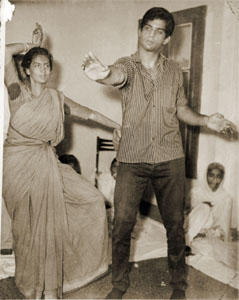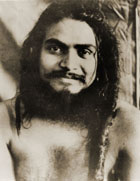![]()
|
|
PRINTER FRIENDLY PDF
FIRST PAGE │
PREVIOUS CHAPTER
Sri Shivabalayogi
10.
Trance
by Prof. S. K. Ramachandra Rao
Download printer-friendly PDF of
Sri Shivabalayogi (1968)
THE TAPOLEELA
Occasionally hard common sense gets knocked by uncanny anomalies. Reason flounders and intellect staggers. The rational facilities by which we have all along been nourished, seem suddenly to give way and the expectation of the unusual and the extraordinary gets the better of our cool intellection.
That there is a beyond to the apparent, that there is a mystery as yet unfathomed by the normal mind, and that here is a universe around and inside ourselves but altogether unknown to us, are discoveries which make a deep impact not only on our imagination but even on our emotions. The experiences involving these discoveries change is with a suddenness and an intensity that are themselves unusual and uncanny.
We then emerge as changed individuals and we can no longer live as we used to live before this conversion. A new zeal and a new vision descend and begin to guide our lives.
We have heard that in ancient times Lord Krishna made Bharata-Varsha holy by his Avatar amongst the animals and inanimate on this earth, people young and old were so drawn to him that the sound of his magic flute and the touch of his divine presence would perform a miracle in them each such that they would emerge changed and chastened beings. This was “Krishna Leela” as people termed it, while Krishna himself laid no claim to the leelas.
Believe it or not, here and now, the twentieth century has produced a Shivabalayogi who has many “Tapoleelas” to his credit but lays no claim to them. The yogi has considered it his duty to wipe the tears of every distressed being that approaches him for succour, radiating into the suppliant a cheer and a titter leading to comfort and peace.
 This process of transformation is brought about by the exalted spiritual powers that the yogi possesses.
This process of transformation is brought about by the exalted spiritual powers that the yogi possesses.
He projects his liberated thought force on an individual or on a mass of people, near and far. In the language of the spiritually minded, the Swamiji can guide and influence people with the good of humanity as the sole objective.
THE TRANCE
People from different parts of the country visiting the Ashram on the weekly bhajans days have witnessed the unusual spectacle of a throng of entranced people dancing and moving about for hours on end, without so much as running into each other or tripping.
The most astounding part of the trance is that some devotees, young and old, climb up slender trees, dance atop fragile branches dangling from them simian fashion and jump down without even a scratch. The Swamiji will be in his own room shut out from the crowd. The trance lasts from two three hours and the entranced will be released by a mere smear of the holy ash on the mid-point of their eyebrows.
This “Trance” or “Bhavasamadhi” depends entirely on the Swamiji’s capacity to invest ordinary humans with divine personalities. This again depends on the degree and level of respectivity [sic] of the devotees.
Thus those in “Trance” take on the distinctive characteristics and Lakshsnas of Rama, Krishna, Siva, Nataraja, Parvathi, Chamundeswari, Raja Rajeswari, HANUMAN and a host of other deities that choose to descend on them. The decsension does not make any distinction between people of different faiths.
THE BENEFIT
The benefits of this Basaya samadhi are ten fold:—
1. Chronic diseases are cured.
2. The “possessed” are freed.
3. God-consciousness is instilled.
4. The ego disappears and a spirit of surrender to God is imbibed.
5. The devotee out-grows his material existence.
6. The devotee attains heights in spirituality.
7. Pain and misery are removed totally.
8. Psycho-Physical development is helped.
9. The dross is drained and spirits instilled to step on the spiritual path.
10. Absolute and implicit faith in the Almighty is brought about.
Download printer-friendly PDF of Sri Shivabalayogi (1968)
